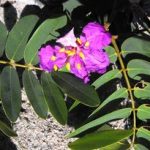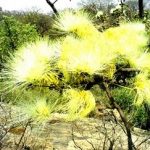TREE LIFE
January 2014
A very Happy New Year from the Tree Society committee to all members. We are looking forward to a healthy, happy, safe and prosperous 2014 for everyone.
– Ed
MASHONALAND CALENDAR
Sunday, 19th January: Christon Bank. A return visit to Christon Bank. This is always an interesting venue with a wide variety of habitats ranging through rocky hills, miombo woodland and riverine vegetation, and with a corresponding variety of trees and plants. Please bring a picnic lunch, a chair, a hat and water. We will meet at 9.30 a.m.
Saturday, 25th January: Monavale Vlei. Our Saturday afternoon walk will be a return visit to Monavale Vlei. where we will look at the wetland flora. Bring wellies or waterproof shoes if possible because it is likely to be wet underfoot. We will meet at 2.30 p.m.
CHANGE IN TREE SOCIETY CABS ACCOUNT
A reminder that the Tree Society CABS account number has been changed from 9015224328 to 1002549477.
So, our bank account is:
Bank: CABS
Account Name: W.R.Clarke Tree Society
Account Number: 1002549477
– Ed
OBITUARY: Malcolm William Clark 8 October 1942 – 1 November 2013
This is to report the sad news of the death of Malcolm Clark on 1 November 2013. The following brief obituary has been provided by Dave Hartung.
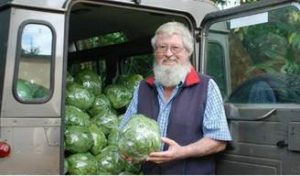
The Late Malcolm William Clark
Malcolm, known to many as “Makabichi” or “The Celery King”, was arguably the best market gardener in Zimbabwe, with his “Top Crop” brand of superb fresh veggies. He was also amazingly knowledgeable on many other subjects, especially woodwork, timber and trees, and was a perfectionist in all he did. Being a keen fisherman, both inland water and deep-sea (record-quality Marlin), he crafted his own ultra-professional rods. His untimely death, mainly due to severe stress and resultant cancer, has left a serious gap in our community.
TREE OF THE MONTH
Khaya anthotheca
Family: Meliaceae. Common names: Red mahogany. S: Mubawa, Muvava.
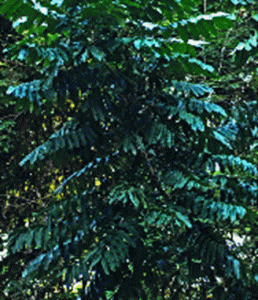
Khaya anthotheca, Red mahogany
In Zimbabwe the Tree of the Year in 2011 was Khaya anthotheca, known here as the Red mahogany. I have given the scientific name first as it has many mahogany names, being one of seven species in the genus Khaya, considered the true African mahoganies. It is also known as the Banket, African, White, Nyasaland, Mozambique, Uganda, etc., etc., mahogany.
There is a story about of the origin of the name Khaya. An early botanical explorer in Africa saw a magnificent tree and asked the guides and porters its name. The prompt reply was ‘Khaya’ which actually meant ‘I don’t know’. Nevertheless, that name was faithfully recorded for that tree and thus became the name for the genus.
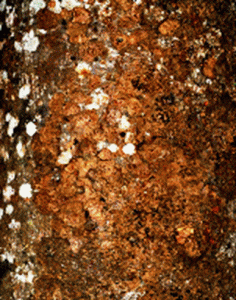
Khaya anthotheca Bark
These are magnificent trees, up 65 m in height as is the ‘Big Tree’ in the Chirinda Forest at Mt Selinda, near Chipinge. Like many very tall trees they need extra support so form buttresses at the bottom. As a result of these buttresses the ‘Big Tree’ has a diameter of about 4.5 m at the base.
The bark is reported to taste bitter, almost like quinine, and an infusion is drunk to relieve colds. I haven’t ever tasted it, nor have I tried the remedy. The leaves are paripinnate with large glossy green leaflets and provide food for the caterpillars of the White-barred Charaxes butterflies. The fruit, defined as a seed surrounded by an envelope, is a woody capsule that splits into four or five valves to release winged seeds.
The Red mahoganies occur in evergreen and riverine fringe forest at medium to low altitudes and are found throughout the Chirinda forest where fortunately they are protected.
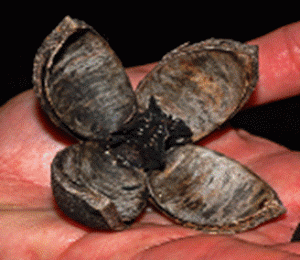
Khaya anthotheca, Red mahogany pod
They also occur in the Honde and Zambezi Valleys and I have seen them at Mana Pools. In Mozambique, Malawi, Zambia and other parts of Africa these trees provide a most important timber and many have been cut down. They grow easily from seed and there was one in Greenwood Park but I have been unable to find it recently.
The photos were taken at Catapú by Olivier Maurin.
– Meg Coates Palgrave
TREE SOCIETY VISIT TO SELDOMSEEN in the VUMBA 15 – 18 November 2013
Day 2: Saturday 16 November
The day dawned cloudless again and it was to remain so all day. We decided to take our lunch with us (pies and salad prepared by Mary and Meg) for a day out in the Bunga Forest. We parked in the lay-by at the western end near the cattle grid and did the upper path on the northern side of the main road. There we were joined by Peter Buttress (only briefly as he was on his way to Harare) and Judy.
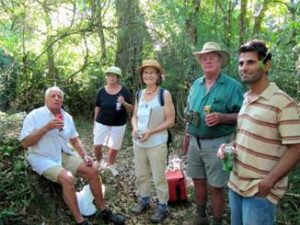
Taking a rest in Bunga Forest, Bvumba
For me it was an almost perfect morning’s botanising: interesting trees, an expert leader (Tom) and nothing physically strenuous. For Tom it had been about 10 years since he was last in the forest and he was disappointed that he could not immediately name everything he saw; I have to report that there was very little that he could not name. Tom had borrowed a small axe from Vernon and was able to investigate the various ‘slashes’ as we went along.
This part of the Bunga has not changed at all in the thirty years I’ve known it. There are no invasions of aliens here. Perhaps it was a bit thinned out by Cyclone Eline in the year 2000.
The small shrub Mostuea brunonis was flowering everywhere and its small white flowers could be seen commonly in the forest throughout the day.
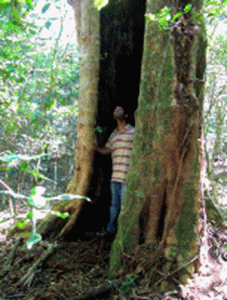
An old tree, Bunga Forest
The main species of tree in the forest were Syzygium guineense subsp. afromontanum and Craibia brevicaudata. Occasional specimens of Croton sylvaticus were also seen.
One of the first nice finds was Cassipourea malosana, Onion wood, in flower. This possesses quite attractive greenish-yellow flowers. The genus belongs to the family Rhizophoraceae, which mainly consists of various species of Mangrove. Like Rubiaceae it has opposite leaves and interpetiolar stipules but the leaves are toothed, whereas in Rubiaceae they are entire.
Rawsonia lucida was everywhere and we soon learned to recognise its spiny-margined leaves and reddish-brown trunk. Soccer ball trees, Tabernaemontana stapfiana, were common and were in flower. No fruits were seen here though.

Homeward bound for lunch, Bvumba
After about 3 hours we emerged into bright sunlight back on to the main tarred road though the forest and headed downhill to the cars. Here was a further group of species which we hadn’t seen before: some herbaceous ones: Solanum aculeatissimum, Impatiens cecilii and the white-flowered Thunbergia, now known as T. usambarica. Formerly this was included with a blue-flowered species which grows at lower altitudes and the group was called T. petersiana. Following a recent revision, T. petersiana is used for the blue-flowered species and T. usambarica for the white-flowered one.
On reaching the car park we discovered that Judy had locked her car keys and her spare set of car keys in her car. Mary took her to fetch Ken Linfoot, who very kindly came to help break in to the car with the help of some wire. This turned out to be quite a mission and Ken laboured for quite a while before finally managing to get in via the door handle.
After lunch, there was a certain amount of moving about as Ken was taken home and Bilal returned to Seldomseen with Tom to pick up a plant press. There was also a considerable debate as to what to do next. In the end, the party split into two.
Tom took a group down the Woodlands Road to the Lower Bunga Forest while Meg, Julia and I decided to remain in the Upper Bunga and explore the forest on the other side of the road.
Our little group came across one of the strangest things – a Newtonia growing at about 1700 m altitude. It was quite a small tree and Tom suggested that it might have arisen from a wind-blown seed. We also came across the large leaves of Neoboutonia macrocalyx, with their stellate-hairy undersides. Also found was a flowering Rubiaceae. Tom suggested it might be Coffea ligustroides, which is an interesting one for me. The Lower Bunga group also had an interesting time and saw a number of new species including Elaeodendron croceum. Both these latter names need to be checked.
In the evening it was Bilal and Graham’s turn to cook and Bilal laboured over the braai, producing some wonderful chicken and salads. The Linfoots were our guests and we ate outside in surprisingly cool conditions. At one stage the skies clouded up with the promise of mist the next day.
It was a long and interesting day with some excellent botanising and the usual good companionship of the Tree Society.
For the record, the power was on all day and certainly when we were inside in the morning and evening, which were the most important times. The Linfoots commented that we had been very lucky.
– Mark Hyde
Day 3: Sunday 17 November
Sunday morning dawned misty but soon cleared to enable us to travel half way down the Eagle School road.
Our first stop on the way was to view the Aloe rhodesiana and then the Giant Lobelia, Lobelia stricklandiae. Further down, on the verge, we came across Plectranthus laxiflorus, with its strong lemon scent. We then saw Piper capense and were particularly taken with its opposite leaves, one with a short lateral shoot. We also saw Schefflera umbellifera, Gymnosporia harveyana and then Cassipourea malosana, a tall tree with parallel branches.
We then drove up Chinziwa with its beautiful rolling hills and an abundance of wild flowers. Just to name a few: Vernonia natalensis, purple-grey, and Vernonia galpinii with dark purple flowers. We also saw Gnidia kraussiana with yellow flowers emerging and Tom Muller recalled how when he was a boy he beat up an older person with that name.
Other species seen: Rhynchosia monophylla with orange red flowers; Indigofera sp., possibly hilaris; Lotus namulensis with white flowers; Stomatanthes africana; Lobelia goetzii, a feature of the Vumba with its purple flowers; a species of Hypoxis with yellow flowers; Verbena brasiliensis, with flowers not over-topping the inflorescence; Protea caffra subsp. gazensis; Helichrysum odoratissimum with large yellow heads and Eriosema buchananii with its reddish-pink flowers.
We also practiced our new Acacia names when we came across a Senegalia polyacantha, formerly known as Acacia polyacantha. We then made our way to a car park (Cloudlands Lay-by) close by. There we discovered Tabernaemontana stapfiana with its very large fruit the size of soccer balls. We also saw Rapanea melanophloeos, Maesa lanceolata, Pavetta umtalensis, a very large Syzygium guineense subsp. afromontanum, Erythroxylum emarginatum with its ‘lizard legs’ young branchlets and Diospyros whyteana, then Cephalanthus natalensis, the Tree Strawberry, Nuxia oppositifolia and Albizia gummifera.
All in all it was a very pleasant morning, with Tom Muller keeping us entertained the whole time.
– Marilyn Dickinson
Sunday afternoon was less successful. A search was made for a patch of lower-altitude Newtonia forest which Tom knew about. However, we weren’t sure who now lives in Edgar Whitehead’s former house below Leopard Rock and, fearing the dobermans, we abandoned the search just outside the moon gate of the house. Had we known in time that the house is still inhabited by a single woman with her dogs, we would have felt braver about crossing one of her paddocks to where we were pretty sure we would still find the Newtonia. We’ll have to go back.
Nearby was one of the most extensive and densest patches of Vernonanthura phosphorica that I have ever seen. This alien bee-plant is spreading rapidly in the Vumba area and adjacent Mozambique.
Another very strange find was an escaped Cornflower, Centaurea cyanus coming up from a crack in a disused part of the road. I’ve never seen it in Zimbabwe before and certainly not as an escapee.
– Mary Lovemore
Day 4: Monday 18 November
No botany was done on this day. Everyone packed up as it started to rain for the first time since we had arrived, then settled up their bills and departed.
Conclusion
Thanks go especially to …
- All the participants for their unfailing tolerance and good humour.
- Peter Buttress for telling us about the Lobelia stricklandiae.
- Tom for leading most of the walks and for sharing his expert knowledge with us.
- Isla for doing most of the initial work in organising the weekend.
Let’s hope it is not 10 years before our next visit to the Vumba.
A number of specimens were collected which need to be identified and we will try and post a follow-up note in a later edition of Tree Life with details of the names.
– Mark Hyde
Sunday 8th December: Christmas Social at Val d’Or, Harare
Our Christmas Social was held on the second Sunday in December and we returned to our favourite venue, Bill Clarke’s property at Val d’Or. Not only is this reasonably close to Harare with some nice woodland, but also there are excellent facilities and we always get a very warm welcome from Bill and Fiona.
Tea and bring-and-share snacks were served from 9.30 a.m. and after a relaxing chat we set off on a short botanical walk, led by Meg Coates Palgrave.
Although this is a well-known area to us, there were some things of interest. One was Coptosperma neurophyllum, the Kopje Butter spoon in flower. This has greenish-white flowers in heads and each flower has a prominent exserted stigma. This species was known for years as Tarenna neurophylla and is quite a common species in woodland and on rocky kopjes, as the name implies.
Also nice to see was a Pod mahogany, Afzelia quanzensis, bearing fruit and it was interesting to note how large two planted specimens of Faidherbia albida have become. Clearly the relatively high altitude (1530 m) is no barrier to them.
After the walk, there was the ever-popular general knowledge quiz, which once again had been very ably compiled by Adele Hamilton-Ritchie. The quiz was followed by the handing out of prizes to the winning teams. The Society also took the opportunity to thank people that have helped us during the year – Tom Muller, Meg Coates Palgrave, Adele Hamilton-Ritchie and J-P Félu, as well as the committee members.
The formal business of the day having been completed, a relaxed lunch followed, lubricated by a supply of wine provided by the Society. We ended the day with a welcome walk around the property, led by Bill. If I might add a final comment as Chairman, the Christmas Social is always a relaxing and pleasant event in the Tree Society’s calendar and it was no exception this year. Our thanks go to Bill and Fiona for hosting us.
– Mark Hyde


